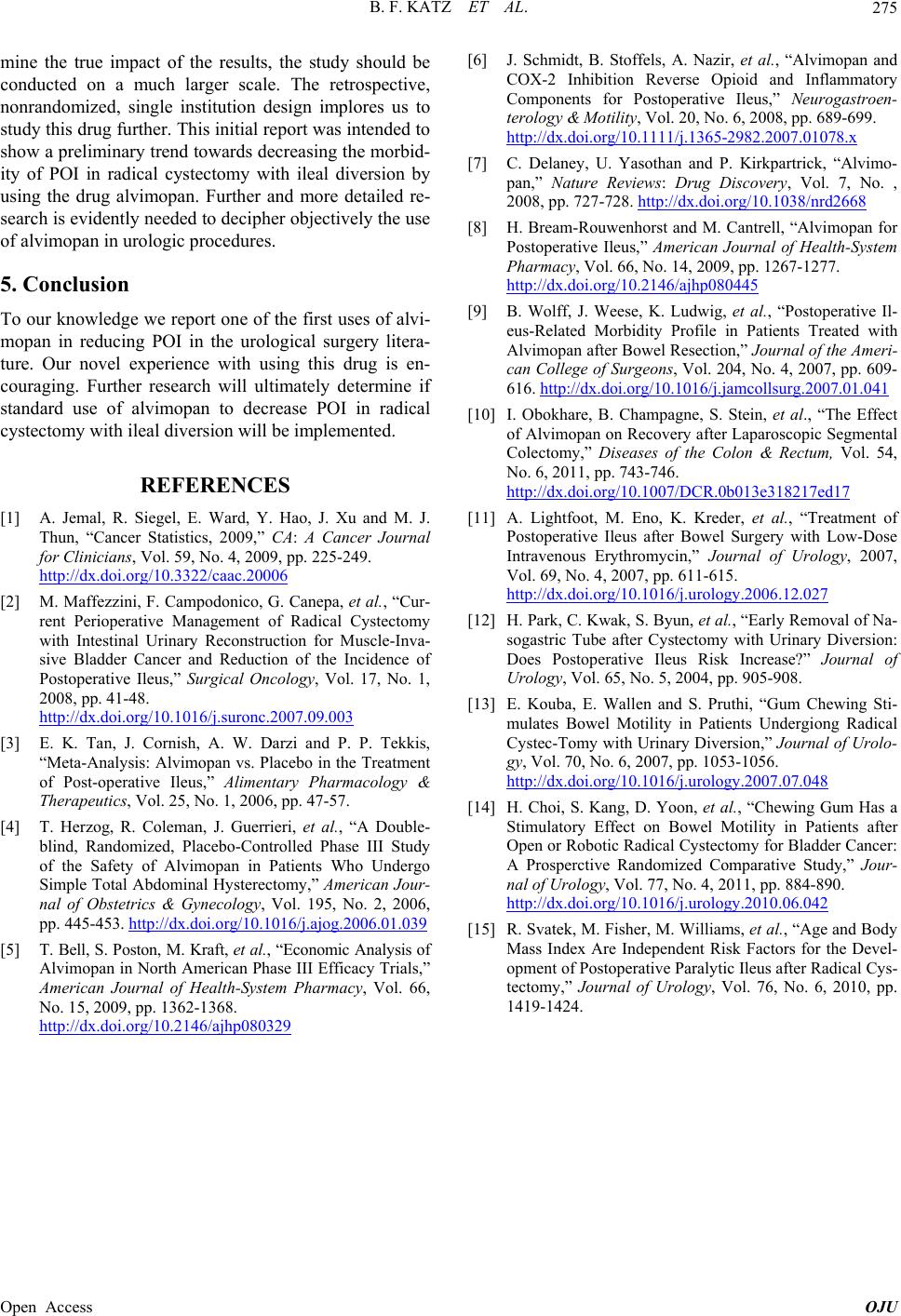
B. F. KATZ ET AL.
Open Access OJU
275
mine the true impact of the results, the study should be
conducted on a much larger scale. The retrospective,
nonrandomized, single institution design implores us to
study this drug further. This initial report was intended to
show a preliminary trend towards decreasing the morbid-
ity of POI in radical cystectomy with ileal diversion by
using the drug alvimopan. Further and more detailed re-
search is evidently needed to decipher objectively the use
of alvimopan in urologic procedures.
5. Conclusion
To our knowledge we report one of the first uses of alvi-
mopan in reducing POI in the urological surgery litera-
ture. Our novel experience with using this drug is en-
couraging. Further research will ultimately determine if
standard use of alvimopan to decrease POI in radical
cystectomy with ileal diversion will be implemented.
REFERENCES
[1] A. Jemal, R. Siegel, E. Ward, Y. Hao, J. Xu and M. J.
Thun, “Cancer Statistics, 2009,” CA: A Cancer Journal
for Clinicians, Vol. 59, No. 4, 2009, pp. 225-249.
http://dx.doi.org/10.3322/caac.20006
[2] M. Maffezzini, F. Campodonico, G. Canepa, et al., “Cur-
rent Perioperative Management of Radical Cystectomy
with Intestinal Urinary Reconstruction for Muscle-Inva-
sive Bladder Cancer and Reduction of the Incidence of
Postoperative Ileus,” Surgical Oncology, Vol. 17, No. 1,
2008, pp. 41-48.
http://dx.doi.org/10.1016/j.suronc.2007.09.003
[3] E. K. Tan, J. Cornish, A. W. Darzi and P. P. Tekkis,
“Meta-Analysis: Alvimopan vs. Placebo in the Treatment
of Post-operative Ileus,” Alimentary Pharmacology &
Therapeutics, Vol. 25, No. 1, 2006, pp. 47-57.
[4] T. Herzog, R. Coleman, J. Guerrieri, et al., “A Double-
blind, Randomized, Placebo-Controlled Phase III Study
of the Safety of Alvimopan in Patients Who Undergo
Simple Total Abdominal Hysterectomy,” American Jour-
nal of Obstetrics & Gynecology, Vol. 195, No. 2, 2006,
pp. 445-453. http://dx.doi.org/10.1016/j.ajog.2006.01.039
[5] T. Bell, S. Poston, M. Kraft, et al., “Economic Analysis of
Alvimopan in North American Phase III Efficacy Trials,”
American Journal of Health-System Pharmacy, Vol. 66,
No. 15, 2009, pp. 1362-1368.
http://dx.doi.org/10.2146/ajhp080329
[6] J. Schmidt, B. Stoffels, A. Nazir, et al., “Alvimopan and
COX-2 Inhibition Reverse Opioid and Inflammatory
Components for Postoperative Ileus,” Neurogastroen-
terology & Motility, Vol. 20, No. 6, 2008, pp. 689-699.
http://dx.doi.org/10.1111/j.1365-2982.2007.01078.x
[7] C. Delaney, U. Yasothan and P. Kirkpartrick, “Alvimo-
pan,” Nature Reviews: Drug Discovery, Vol. 7, No. ,
2008, pp. 727-728. http://dx.doi.org/10.1038/nrd2668
[8] H. Bream-Rouwenhorst and M. Cantrell, “Alvimopan for
Postoperative Ileus,” American Journal of Health-System
Pharmacy, Vol. 66, No. 14, 2009, pp. 1267-1277.
http://dx.doi.org/10.2146/ajhp080445
[9] B. Wolff, J. Weese, K. Ludwig, et al., “Postoperative Il-
eus-Related Morbidity Profile in Patients Treated with
Alvimopan after Bowel Resection,” Journal of the Ameri-
can College of Surgeons, Vol. 204, No. 4, 2007, pp. 609-
616. http://dx.doi.org/10.1016/j.jamcollsurg.2007.01.041
[10] I. Obokhare, B. Champagne, S. Stein, et al., “The Effect
of Alvimopan on Recovery after Laparoscopic Segmental
Colectomy,” Diseases of the Colon & Rectum, Vol. 54,
No. 6, 2011, pp. 743-746.
http://dx.doi.org/10.1007/DCR.0b013e318217ed17
[11] A. Lightfoot, M. Eno, K. Kreder, et al., “Treatment of
Postoperative Ileus after Bowel Surgery with Low-Dose
Intravenous Erythromycin,” Journal of Urology, 2007,
Vol. 69, No. 4, 2007, pp. 611-615.
http://dx.doi.org/10.1016/j.urology.2006.12.027
[12] H. Park, C. Kwak, S. Byun, et al., “Early Removal of Na-
sogastric Tube after Cystectomy with Urinary Diversion:
Does Postoperative Ileus Risk Increase?” Journal of
Urology, Vol. 65, No. 5, 2004, pp. 905-908.
[13] E. Kouba, E. Wallen and S. Pruthi, “Gum Chewing Sti-
mulates Bowel Motility in Patients Undergiong Radical
Cystec-Tomy with Urinary Diversion,” Journal of Urolo-
gy, Vol. 70, No. 6, 2007, pp. 1053-1056.
http://dx.doi.org/10.1016/j.urology.2007.07.048
[14] H. Choi, S. Kang, D. Yoon, et al., “Chewing Gum Has a
Stimulatory Effect on Bowel Motility in Patients after
Open or Robotic Radical Cystectomy for Bladder Cancer:
A Prosperctive Randomized Comparative Study,” Jour-
nal of Urology, Vol. 77, No. 4, 2011, pp. 884-890.
http://dx.doi.org/10.1016/j.urology.2010.06.042
[15] R. Svatek, M. Fisher, M. Williams, et al., “Age and Body
Mass Index Are Independent Risk Factors for the Devel-
opment of Postoperative Paralytic Ileus after Radical Cys-
tectomy,” Journal of Urology, Vol. 76, No. 6, 2010, pp.
1419-1424.